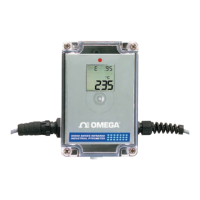In Appendix A, we showed how emissivity is an important
parameter in calculating the temperature of an object via infrared
means. In this section we discuss how to determine a specific
emissivity value. If you know the material of the object, use Table
B-1 in Appendix B to look up its approximate emissivity. Most
organic materials such as plastics, cloth, or wood have an emissivity
of about 0.95. For this reason, we use 0.95 as the default emissivity
setting in the OS550A Series thermometers.
For objects of unknown material or for very precise measurements,
use one of the following methods to determine a specific emissivity
value.
Method 1
1. Measure and record the temperature of the object using a contact
temperature probe such as a thermocouple or RTD.
2. Aim the thermometer at the object.
3. Adjust the emissivity until the temperature reading of the
thermometer equals the temperature measured in Step 1.
Method 2
1. Heat the object (or at least a sample of the object material) on top
of a heating plate to a known temperature. Make sure the
thermometer and the air surrounding the heating plate are at the
same temperature.
2. Measure the temperature of the object material with the
thermometer. Make sure that the object fills the FOV of the
thermometer.
3. Adjust the emissivity until the temperature reading of the
thermometer equals the known temperature of Step 1.
Appendix: Determining an Unknown Emissivity
C
C-1

